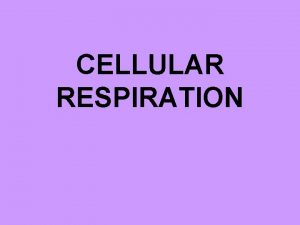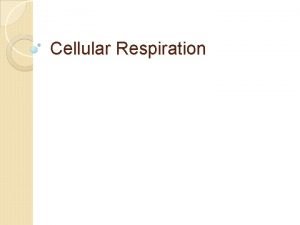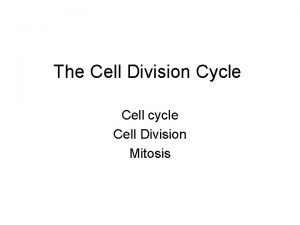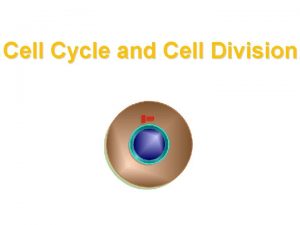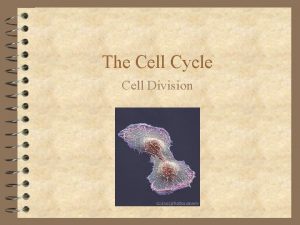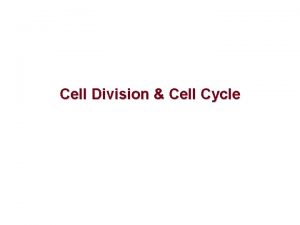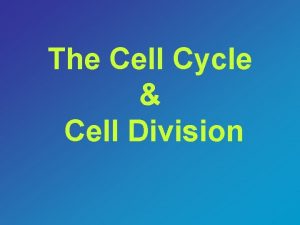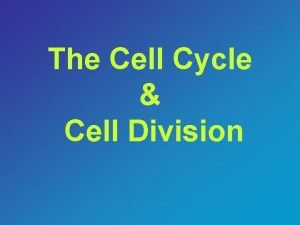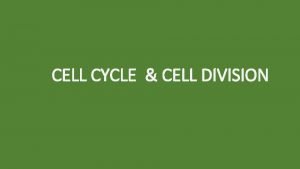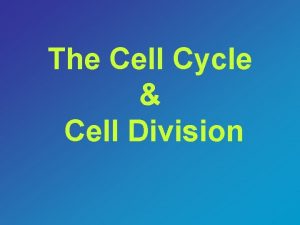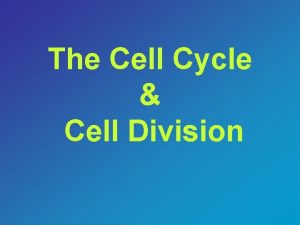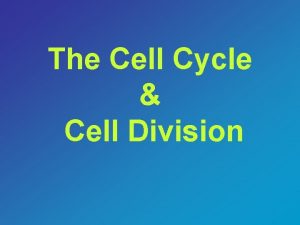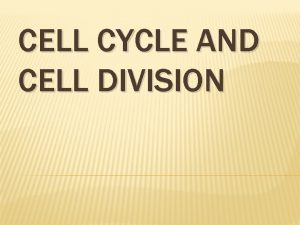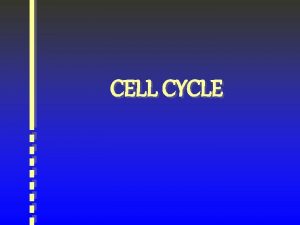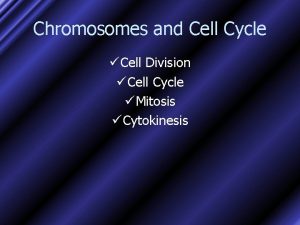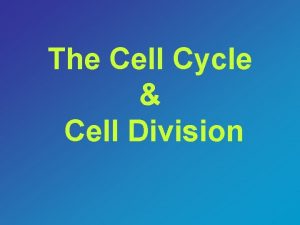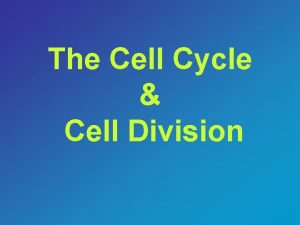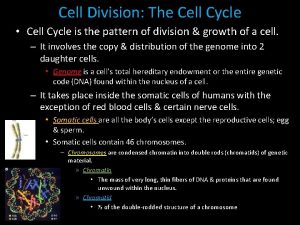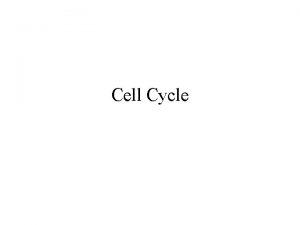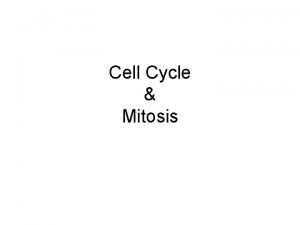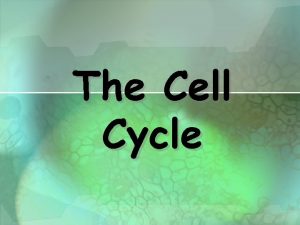The Cell Cycle Cellular Division 1 I Cell




















































- Slides: 52

The Cell Cycle & Cellular Division 1

I. Cell Division: • All cells are derived from preexisting cells (Cell Theory) • Cell division is the process by which cells produce new cells 2

I. Cell Division: • Cells grow in number, NOT in size – Smaller cells more efficient (cellular transport, cellular communication/signaling) – Easier to take in nutrients & get rid of wastes 3

How Often Do Cells Divide? • Some cells must be repaired often such as cells lining the intestines, white blood cells, skin cells; cells with a short lifespan • Other cells DO NOT divide at all after birth such as muscle, nerve cells, brain cells, female egg cells 4

II. Reasons for Cell Division: • Cell growth • Repair & replacement of damaged cell parts • Growth and development of an embryo • Cell is too large. 5

r = 1 cm SA = 4 x 3. 14 x 1 cm 2= 12. 56 cm 2 V = 4/3 x 3. 14 x 1 cm 3 = 4. 19 cm 3 SA / V = 3 r = 2 cm SA = 4 x 3. 14 x 4 cm 2= 50. 24 cm 2 r = 3 cm V = 4/3 x 3. 14 x 8 cm 3 = 33. 49 cm 3 SA = 4 x 3. 14 x 9 cm 2= 113. 04 cm 2 SA / V = 1. 5 V = 4/3 x 3. 14 x 27 cm 3 = 113. 04 cm 3 6 SA / V = 1 6

Large cells • When the surface area and volume get too close in number, the cell will divide. – Ratio close to 1: 1. • Cells are much better functioning when there is more surface area than volume. – 3: 1 or 10: 1 7

III. Chromosomes & Their Structure: • The plans for making cells are coded in DNA • DNA, deoxyribonucleic acid, is a long thin molecule that stores genetic information • DNA is organized into giant molecules called chromosomes 8

III. Chromosomes & Their Structure: • Chromosomes are made of protein & a long, single, tightlycoiled DNA molecule visible only when the cell divides • When a cell is NOT dividing the chromosome (DNA) is less visible & is called chromatin 9

III Chromosomes & Their Structure: • Centromeres hold duplicated chromosomes together before they are separated in mitosis • When DNA makes copies of itself before cell division, each half of the chromosome is called a sister chromatid – Each sister chromatid contains identical genetic information 10

IV. Cell Cycle & Cell Division: • Eukaryotes (nucleus & membrane-bound organelles) must be copied exactly so the 2 new cells formed from division will be exactly alike – The original parent cell & 2 new daughter cells must have IDENTICAL chromosomes – Ex: Humans have 46 chromosomes in our somatic cells (body cells). After one of these somatic cells goes through mitosis, 2 daughter cells are produced each having 46 chromosomes (genetically identical). 11

IV. Cell Cycle & Cell Division: • Both the nucleus (mitosis) and the cytoplasm (cytokinesis) must be divided during cell division in eukaryotes 12

IV. Cell Cycle & Cell Division: • Cells go through phases or a cell cycle during their life before they divide to form new cells – Cell cycle is about 12 -24 hrs. for most animal cells – Cell cycle is controlled by proteins and enzymes 13

IV. Cell Cycle & Cell Division: • The cell cycle includes 3 main parts --interphase, mitosis, and cytokinesis – mitosis = nuclear division – cytokinesis = division of the cytoplasm 14

A. Interphase: • Interphase is the longest part of a cell's life cycle and is called the "resting stage" because the cell isn't dividing Animal Cell Plant Cell Nucleus 15

A. Interphase: • Divided into 3 stages: 1) G 1 (Gap 1) = cell is growing, carrying out normal cell functions, preparing to replicate DNA – Cells mature & increase in size by making more cytoplasm & organelles 16

A. Interphase: 2) S (synthesis) = DNA is copied or replicated – DNA is in the form of chromatin (uncoiled DNA) and is NOT visible 17

A. Interphase: 3) G 2 (Gap 2) =cell prepares for nuclear division (mitosis) – cells makes all the structures needed to divide 18

Centrioles Nucleolus Cell membrane Nucleus 19

B. 4 Stages of Mitosis: • Division of the nucleus or mitosis occurs first • Mitosis is an asexual method of reproduction – Only one parent cell – Daughter cells have SAME number of chromosomes (genetic info. ) • Mitosis consists of 4 stages --- prophase, metaphase, anaphase, & telophase 20

. Prophase: • Longest phase of MITOSIS • Chromatin (uncoiled DNA) condenses and coils into the form of chromosomes – chromosomes are visible (shaped like a “X”) • Sister chromatids (half of a “X”) attach to each other by the centromere 21

. Prophase: • Centrioles in animal cells move to opposite ends of cell • Spindle forms from each centriole (ONLY in animal cells) – Plant cells DO NOT have centrioles (spindle forms from a microtubule) • Nuclear membrane dissolves (disappears) • Nucleolus disintegrates 22

. Prophase: Animal Cell Chromosomes Plant Cell 23

Spindle Fibers Centrioles Centromere Chromosome 24

2. Metaphase: • Shortest phase of MITOSIS • Chromosomes line up in center or equator of the cell • the centromere of each chromosome attaches to spindle fibers 25

2. Metaphase: Animal Cell Spindle fibers Plant Cell 26

Chromosome 27

3. Anaphase: • Spindle fibers attached to the centriole pull the sister chromatids apart at their centromere • Separated chromosomes travel along the spindle fibers to the two poles (ends) of the cell. 28

3. Anaphase: Sister chromatids Animal Cell Sister chromatids Plant Cell 29

Sister Chromatids (genetically identical) 30

4. Telophase: • Nuclear membrane forms at each end of the cell around the chromosomes • Nucleolus reforms • Spindle fibers begin to break down • Chromosomes become less tightly coiled & appear as chromatin again • Cytokinesis begins 31

4. Telophase: Animal Cell Plant Cell 32

Nuclear membrane (forming) Nucleolus (forming) DNA uncoilingbecoming chromatin 33

C. Cytokinesis: • Cytokinesis = division of the cytoplasm of the cell and its organelles separate into 2 new daughter cells (genetically IDENTICAL) 34

C. Cytokinesis: • In animals, a groove called the cleavage furrow forms pinching the parent cell in two 35

C. Cytokinesis: • In plants, a cell plate forms down the middle of the cell where the new cell wall will be 36

C. Cytokinesis: 2 new daughter cells (genetically IDENTICAL) 37

V. Cancer: • Cell division must be controlled, otherwise cell growth will occur without limit (cancer) – DNA mutations lead to changes in the proteins/enzymes that regulate the cell cycle Cancerous Kidney Cells 38

VI. Cancer: • Cancer = a cell or group of cells that grow out of control and create a tumor • Crowds out normal cells and results in the loss of tissue function Cancerous Kidney Cells 39

VI. Cancer: – Tumor = mass of growing, unregulated cells • 2 types of tumors: 1. Benign- tumor that does not spread 2. Malignant- tumor that spreads and destroys healthy tissue 40

Causes of cancer: • Genetics (family history) • Smoking • Carcinogens (cancer-causing chemicals) • Viruses: – HPV can lead to cancer of reproductive organs • Radiation: • Sunlight- skin cancer 41

What phase of the cell cycle would this be? • PROPHASE 42 http: //www. jburroughs. org/science/resources/mitosis/cellcycle. html

What phase of the cell cycle would this be? • ANAPHASE 43 http: //www. jburroughs. org/science/resources/mitosis/cellcycle. html

What phase of the cell cycle would this be? • INTERPHASE 44 http: //www. jburroughs. org/science/resources/mitosis/cellcycle. html

What phase of the cell cycle would this be? • TELOPHASE 45 http: //www. jburroughs. org/science/resources/mitosis/cellcycle. html

What phase of the cell cycle would this be? • METAPHASE 46 http: //www. jburroughs. org/science/resources/mitosis/cellcycle. html

Can you identify 5 stages? http: //district. bluegrass. kctcs. edu/billd. snyder/sharedfiles/biowebsite/Biology. Labs/BIO 137/1 47 37 Lab 2/Lab 2 Mitosis. Slides. html

Mitosis occurring in ANIMAL CELLS 48

Mitosis occurring in PLANT CELLS 49

50

51

Crash Course Mitosis: Splitting up is Complicated 52
 Cell cycle and cell division
Cell cycle and cell division Cell cycle and cell division
Cell cycle and cell division Steps of cell cycle
Steps of cell cycle Cellular transport and the cell cycle
Cellular transport and the cell cycle Biology.arizona.edu/cell bio/activities/cell cycle/01.html
Biology.arizona.edu/cell bio/activities/cell cycle/01.html What type of cell performs cellular respiration
What type of cell performs cellular respiration Where in the cell does cellular respiration occur
Where in the cell does cellular respiration occur Cellular respiration formula
Cellular respiration formula Short division vs long division
Short division vs long division Long division vs synthetic division
Long division vs synthetic division Long division terminology
Long division terminology It is the shorthand method of polynomial division
It is the shorthand method of polynomial division Hát kết hợp bộ gõ cơ thể
Hát kết hợp bộ gõ cơ thể Ng-html
Ng-html Bổ thể
Bổ thể Tỉ lệ cơ thể trẻ em
Tỉ lệ cơ thể trẻ em Voi kéo gỗ như thế nào
Voi kéo gỗ như thế nào Tư thế worm breton là gì
Tư thế worm breton là gì Chúa sống lại
Chúa sống lại Các môn thể thao bắt đầu bằng tiếng đua
Các môn thể thao bắt đầu bằng tiếng đua Thế nào là hệ số cao nhất
Thế nào là hệ số cao nhất Các châu lục và đại dương trên thế giới
Các châu lục và đại dương trên thế giới Công thức tiính động năng
Công thức tiính động năng Trời xanh đây là của chúng ta thể thơ
Trời xanh đây là của chúng ta thể thơ Cách giải mật thư tọa độ
Cách giải mật thư tọa độ Làm thế nào để 102-1=99
Làm thế nào để 102-1=99 độ dài liên kết
độ dài liên kết Các châu lục và đại dương trên thế giới
Các châu lục và đại dương trên thế giới Thơ thất ngôn tứ tuyệt đường luật
Thơ thất ngôn tứ tuyệt đường luật Quá trình desamine hóa có thể tạo ra
Quá trình desamine hóa có thể tạo ra Một số thể thơ truyền thống
Một số thể thơ truyền thống Cái miệng xinh xinh thế chỉ nói điều hay thôi
Cái miệng xinh xinh thế chỉ nói điều hay thôi Vẽ hình chiếu vuông góc của vật thể sau
Vẽ hình chiếu vuông góc của vật thể sau Nguyên nhân của sự mỏi cơ sinh 8
Nguyên nhân của sự mỏi cơ sinh 8 đặc điểm cơ thể của người tối cổ
đặc điểm cơ thể của người tối cổ V. c c
V. c c Vẽ hình chiếu đứng bằng cạnh của vật thể
Vẽ hình chiếu đứng bằng cạnh của vật thể Fecboak
Fecboak Thẻ vin
Thẻ vin đại từ thay thế
đại từ thay thế điện thế nghỉ
điện thế nghỉ Tư thế ngồi viết
Tư thế ngồi viết Diễn thế sinh thái là
Diễn thế sinh thái là Các loại đột biến cấu trúc nhiễm sắc thể
Các loại đột biến cấu trúc nhiễm sắc thể Bảng số nguyên tố
Bảng số nguyên tố Tư thế ngồi viết
Tư thế ngồi viết Lời thề hippocrates
Lời thề hippocrates Thiếu nhi thế giới liên hoan
Thiếu nhi thế giới liên hoan ưu thế lai là gì
ưu thế lai là gì Hổ sinh sản vào mùa nào
Hổ sinh sản vào mùa nào Khi nào hổ con có thể sống độc lập
Khi nào hổ con có thể sống độc lập Sơ đồ cơ thể người
Sơ đồ cơ thể người Từ ngữ thể hiện lòng nhân hậu
Từ ngữ thể hiện lòng nhân hậu





